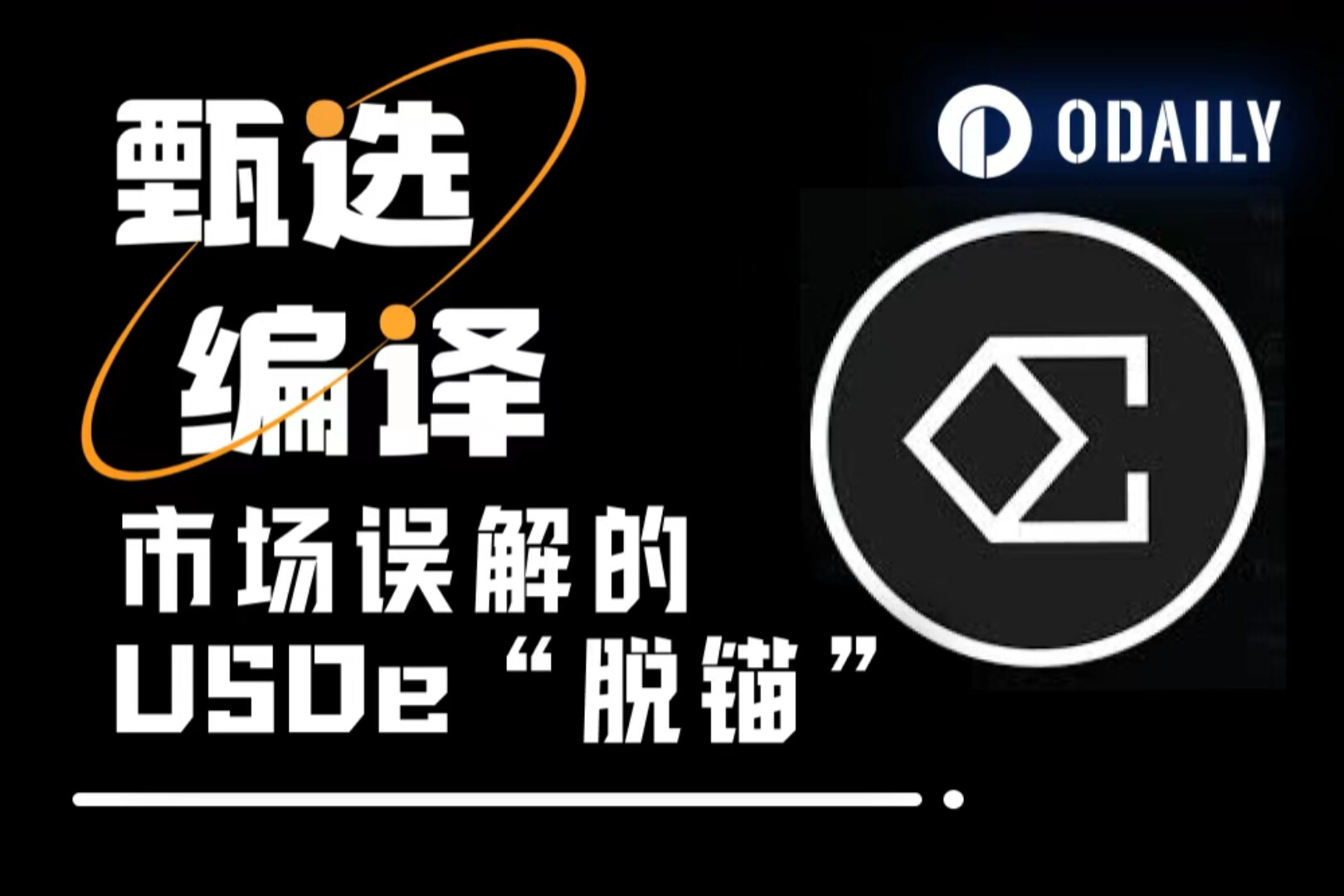With the Intercontinental Exchange (ICE), the parent company of the New York Stock Exchange, announcing on October 7 that it plans to invest $2 billion in the prediction market platform Polymarket at a valuation of approximately $9 billion, just three days later, another prediction market giant Kalshi also announced the completion of a $300 million financing round, with a valuation of $5 billion.
Meanwhile, Polymarket founder Shayne Coplan, who has repeatedly retweeted or liked posts about the platform's potential token launch, recently listed a string of major crypto asset symbols on social media, followed by the $POLY ticker, effectively signaling a token launch. This series of announcements triggered a wave of fear-mongering (FOMO) among community members. As the news spread, the prediction market sector once again became a hot topic.
BlockBeats has compiled some practical tips and tools to help you better participate in airdrops on major prediction market platforms. Below, we'll introduce strategies for boosting volume on platforms like Polymarket, Kalshi, Myriad, and Limitless.
Polymarket
Although there are rumors that Polymarket has already taken an airdrop snapshot, it is still necessary to participate.
Polymarket, one of the largest decentralized prediction markets, has designed its mechanisms to provide liquidity incentives. To encourage users to provide liquidity in the order book, Polymarket has launched a limit order liquidity reward program. Users who place buy or sell orders close to the market mid-price (effectively acting as market makers) in the order book receive daily rewards. These rewards are funded from the Polymarket treasury and calculated based on the order book depth and proximity to the mid-price. Simply put, the closer the order price is to the current market mid-price and the larger the number of orders placed, the higher the reward.
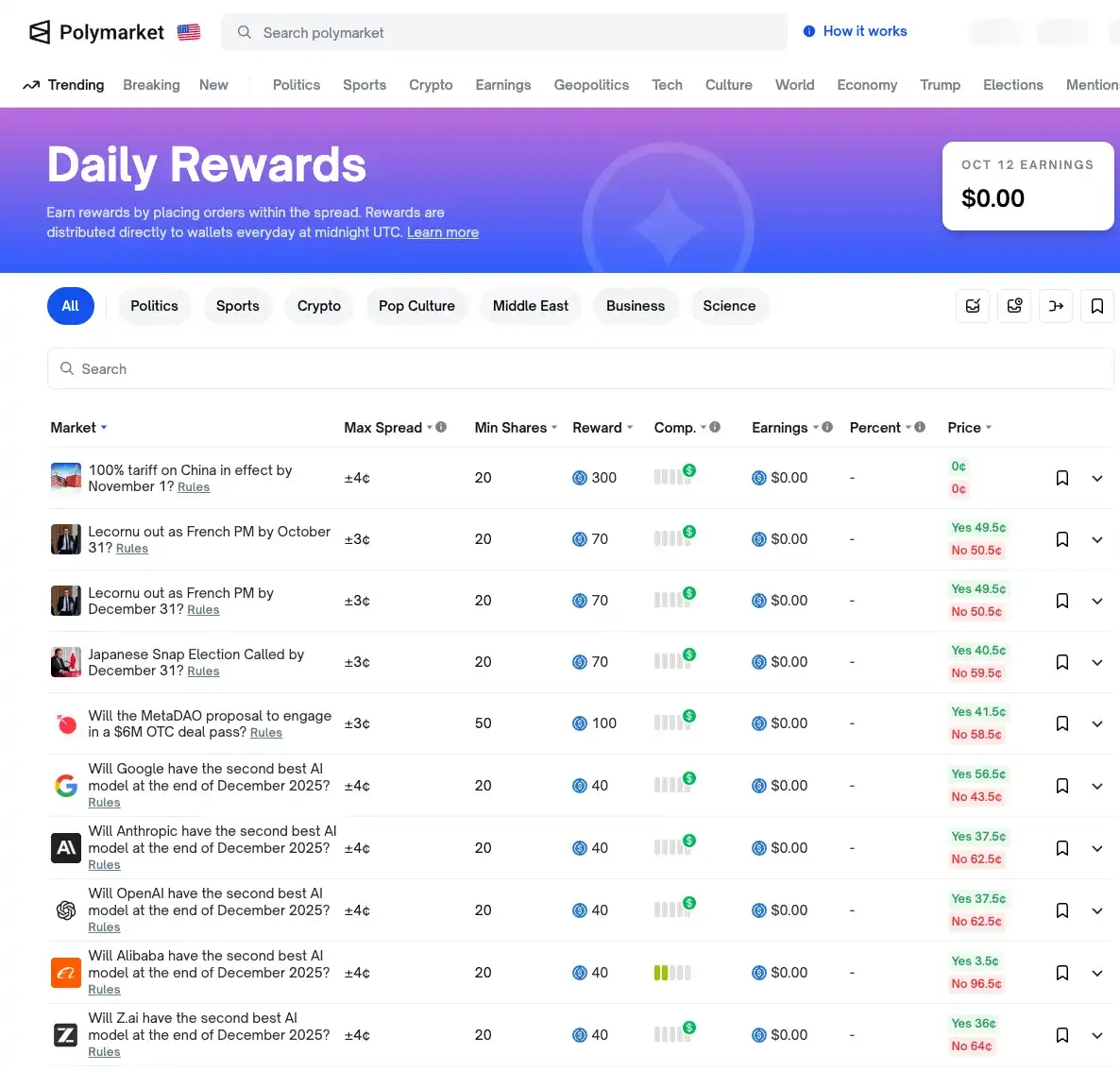
This mechanism has given rise to a method of extreme order arbitrage. Some users place large buy orders at the extreme ends of the price range. When the market fluctuates violently and the probability of an event is temporarily underestimated, these low-priced buy orders are automatically executed, allowing users to pick up bargains and then sell them for a profit when the price returns to normal. Because these orders are often placed far from the mid-price, the cost is minimal, yet they can take advantage of panic selling in the market, allowing for cost-effective position building. Furthermore, these orders that are not immediately executed can earn platform liquidity rewards while they wait. However, it is important to note that this strategy carries certain risks.
In addition to liquidity incentives, Polymarket also offers a long-term holding interest mechanism to stabilize prices in long-term event markets. The platform offers a 4% annualized holding reward for selected long-term markets. For users holding positions in these markets, the platform randomly samples their holdings every hour and distributes interest daily. Therefore, one strategy for wash trading involves holding long-term positions in these markets to generate stable returns, while mitigating the risk of price volatility by hedging in related markets. For example, if you hold a large "yes" position in a "candidate elected" market and are earning interest, you can short an equal position in a related "other candidate elected" market to offset the risk and earn only the interest earned on your holdings.
Another common technique is to exploit risk-free arbitrage in related markets. This principle is similar to hedging in contract trading to profit from rate differentials. If there are multiple related markets for the same event, traders can monitor whether their prices deviate from a reasonable probability relationship. If the sum of the prices in two markets is not equal to 1 (i.e., the sum of the probabilities on both sides deviates from 100%), traders can simultaneously buy the undervalued market and short the overvalued market, locking in risk-free returns.
For example, if the market price for "A Wins" is 0.40 (implying a 40% probability) and the market price for "B Wins" is 0.50 (implying a 50% probability), the combined probability of the two outcomes is only 90%, not 100%. This means that the market as a whole is underestimating the likelihood of a particular outcome. In this case, you can buy the undervalued A Wins contract and sell (short) an equal number of contracts in the B Wins market. The total investment cost for both contracts is less than $1. Holding until settlement yields a risk-free profit.
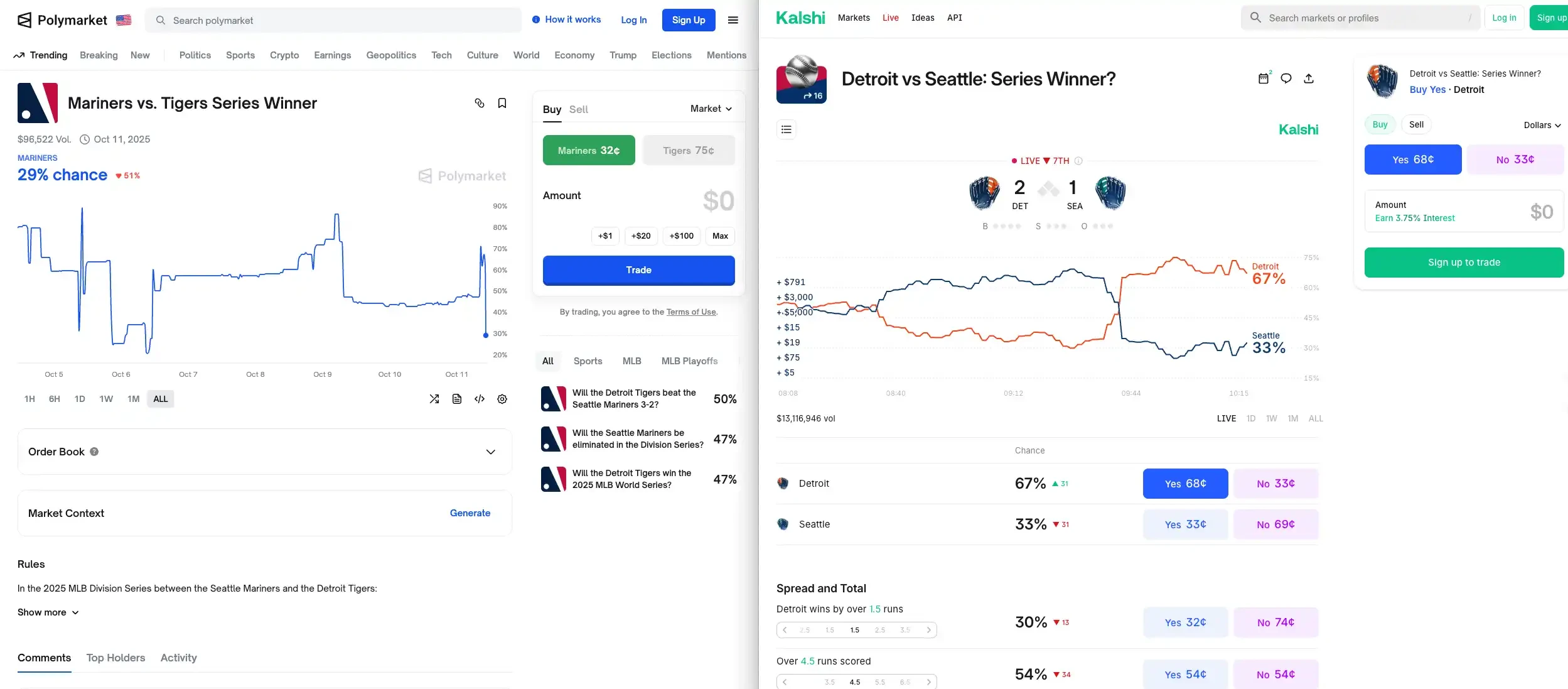
Thanks to Polymarket's ecosystem support and active community, a variety of specialized arbitrage tools have emerged on the market. For example, the Polyfactual platform operates a cross-platform arbitrage bot that continuously monitors price quotes for the same event on multiple platforms, including Polymarket and Kalshi, and instantly buys and sells to lock in profits when a price discrepancy is detected. The platform also issues tokens, allowing holders to share arbitrage profits proportionally to their holdings. Nevua Markets allows users to set keyword alerts to capture price discrepancies between different markets.
In addition, the community has developed tools like PolySights and Polyburg for real-time monitoring of market spreads, depth, and transaction data. This data, combined with simple Python scripts, can help identify arbitrage or high-probability opportunities. The Polymarket Analytics platform, now officially integrated, offers robust data and supports querying by market or address, including trading volume, open interest, price trends, and detailed metrics such as account profit and loss and position changes.
To summarize, small-position users are more suitable for earning liquidity rewards by placing limit orders to increase trading volume; while large-position users can hold positions in specific markets for a long time to earn holding interest and reduce risks by hedging related markets.
Kalshi
Kalshi's annual trading volume has surged from $300 million last year to a projected $50 billion this year. In recent months, it has surpassed Polymarket to capture over 60% of the prediction platform market. Kalshi has also partnered with major brokerages like Robinhood and Webull to embed event contract trading into investment apps commonly used by millions of retail investors. This has significantly increased the accessibility of prediction markets to the general public, making them a must-see opportunity.
Kalshi charges a transaction fee of approximately 0.7% to 3.5% of the contract value (varies depending on the price) for each trade. The platform does not directly profit from users' profits or losses. However, all pending limit orders are fee-free. This Maker incentive ensures ample liquidity in the order book.
By leveraging Kalshi's fee policy, users can significantly reduce transaction costs by placing orders, thereby generating significant trading volume with minimal capital. For example, limit orders are often used to provide liquidity. Kalshi does not charge fees for orders that are not immediately filled, and even waives transaction fees for acting as a market maker after orders are filled. Therefore, users seeking to increase trading volume should avoid directly "taking" orders and instead place orders at more favorable prices and wait for them to be filled.
For example, if you're optimistic about a certain event, you don't need to immediately place a sell order; instead, you can place a buy order at a slightly lower price. Conversely, even if a placed order isn't executed immediately, no fees will be incurred, and users can cancel the order or adjust the price at any time. By continuously placing orders and frequently adjusting quotes based on market fluctuations, you can accumulate trading volume when price gaps narrow while avoiding the high fees associated with frequent order execution.
Selecting niche markets with information asymmetry is another way to generate large returns with a small investment. Popular markets on Kalshi (such as the Federal Reserve interest rate decision and the presidential election) are highly competitive and price-efficient, making it difficult for ordinary users to gain an advantage. Conversely, less popular markets, with even greater information asymmetry, are more suitable for intensive cultivation, where small investments can yield high returns.
Experienced traders recommend focusing on niche markets such as "quarterly earnings reports from small public companies" or "weather indicators in specific regions." If you have research in the relevant field or access to official statistics, you can assess the probability of these events more accurately than most. These markets often experience low trading volume and volatile prices in the early stages. By repeatedly placing small orders, you can not only generate significant trading volume but also potentially generate excess returns as prices revert.
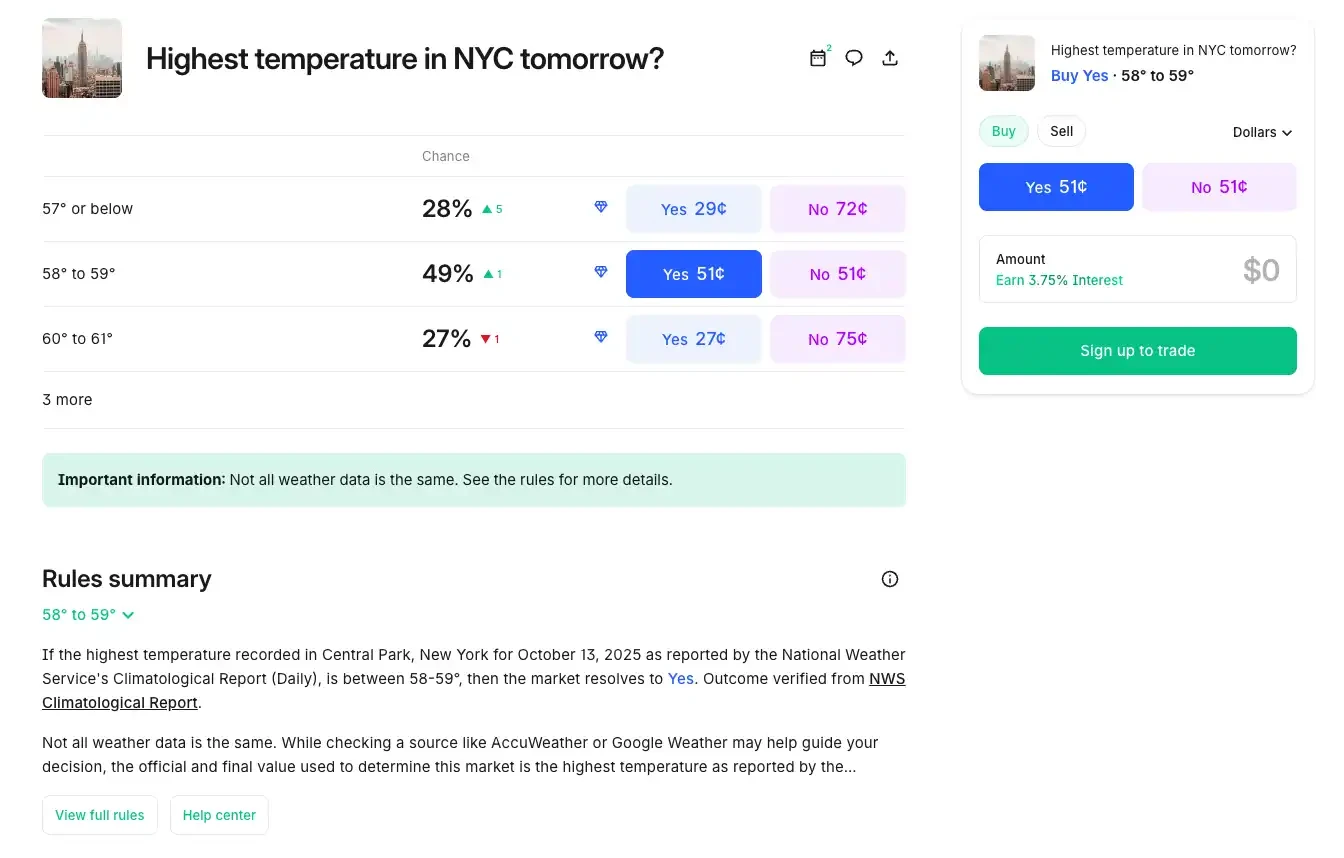
Argona 0x, an X platform user, shared his experience. Starting with just $10, he specifically targeted markets with high information asymmetry, making 20-30 small trades daily. He also took advantage of Kalshi's free tournaments and points programs, earning an additional $40 in weekly rewards. While individual strategies vary, focusing on niche areas and leveraging one's informational advantages is a proven, low-cost way to increase trading volume.
To manage risk, avoid placing a large portion of your capital on a single market; moderate diversification is essential. Especially for markets with low liquidity, it's important to set a stop-loss, such as exiting a position immediately when losses reach 5-10% of your total capital, to avoid significant losses from unexpected market fluctuations. Experienced traders share that they typically participate in three to five different markets on Kalshi, investing no more than 20% of their total capital in each market. This effectively mitigates the impact of "black swan" events on overall returns.
The openness of the Kalshi ecosystem has also spawned a variety of third-party tools and strategies, helping users improve their efficiency and success rate in trading volume. Some community developers have aggregated data from multiple prediction platforms to create cross-platform market dashboards, making it easier to monitor price differences between Kalshi and platforms like Polymarket.
For example, ArbBets is an arbitrage scanning tool that can scan for arbitrage opportunities across betting and prediction markets. It simultaneously monitors over 100 traditional betting and prediction platforms, including Polymarket and Kalshi, and identifies any inconsistent quotes for the same event in real time, prompting users to simultaneously buy both contracts to lock in risk-free profits. Furthermore, ArbBets offers a positive expected value (+EV) betting filter, helping users identify investment opportunities on Kalshi or Polymarket where the odds of winning are greater than the probability implied by the odds.
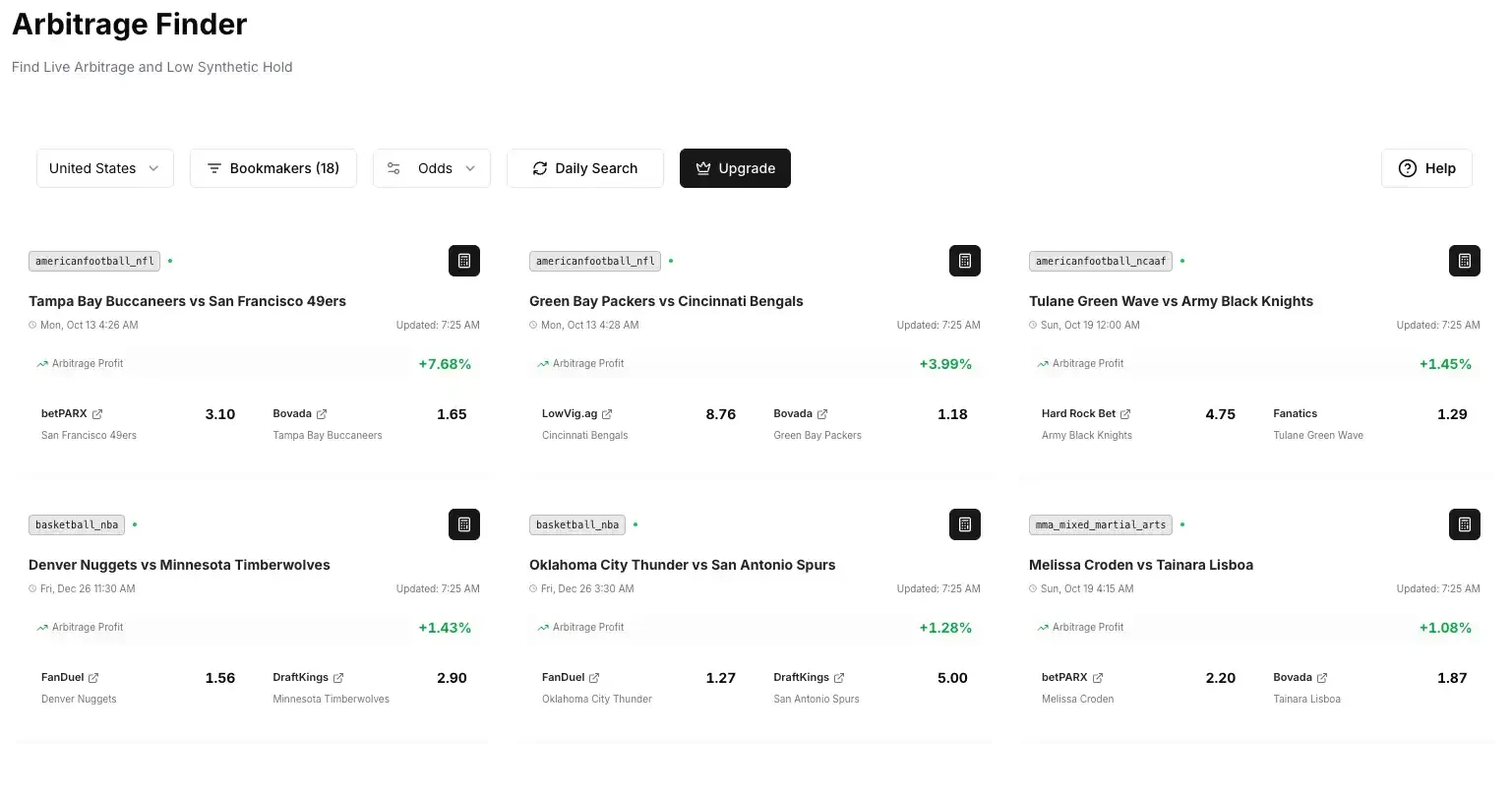
Another example is the Billy Bets AI Agent, which combines real-time data with machine learning models to automatically identify high-probability betting options and execute them on your behalf. For example, Billy offers a natural language trading terminal, allowing users to enter commands like "What are some positive EV bets for tonight's NFL football?" The system instantly returns matching odds and automatically places the order, while also providing real-time ROI tracking.
According to official disclosures, since its launch in June 2025, the Billy terminal has routed over $1 million in betting transactions, with weekly trading volume increasing by 23%. This AI agent lowers the barrier for users to make independent decisions and is particularly user-friendly for those seeking to passively acquire high-probability trades.
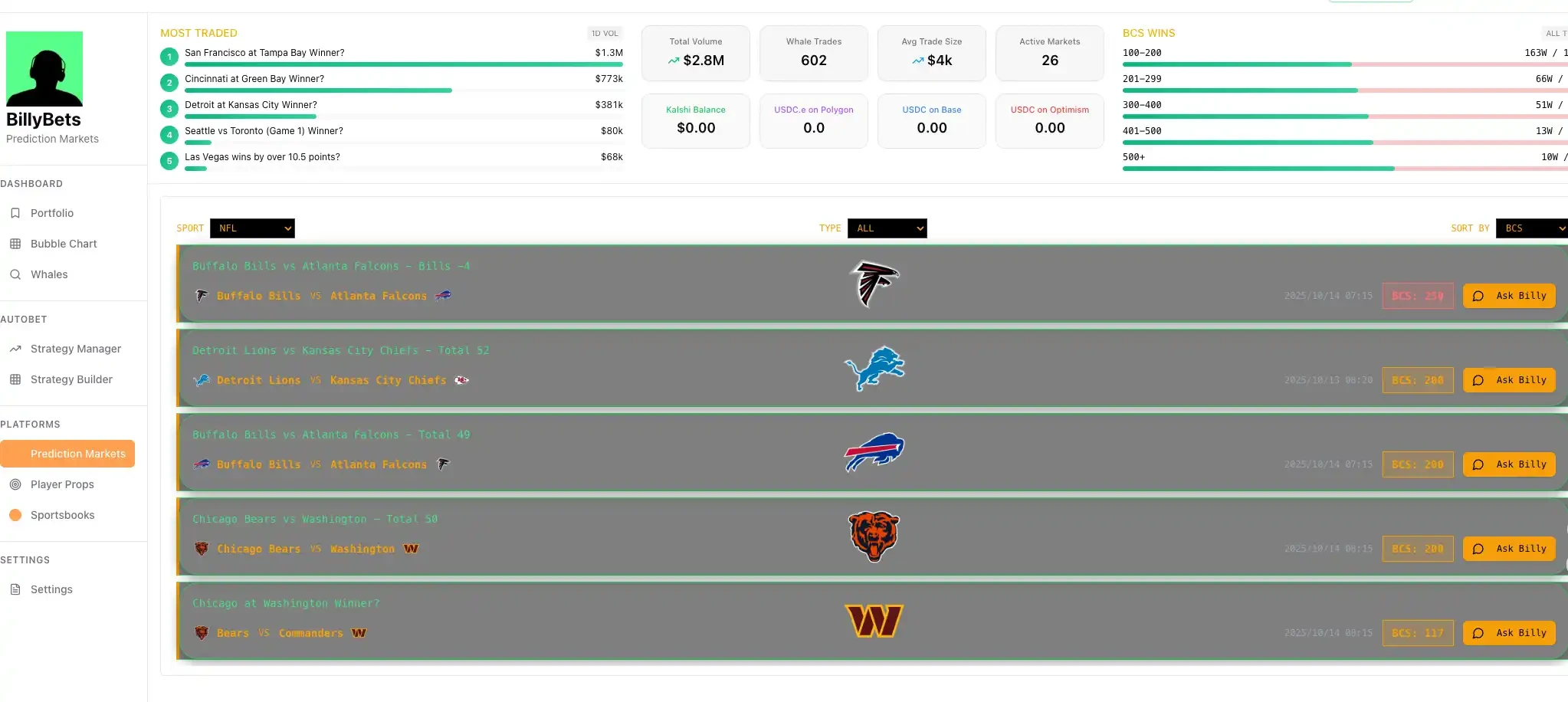
Myriad
Myriad is a Web 3 prediction market protocol incubated by Decrypt's parent company, DASTAN. Its defining feature is the ability to embed prediction markets within news media content. This means that while reading a Decrypt article or listening to a Rug Radio podcast, you can directly participate in predictions on related topics within the page. As of early October 2025, the Myriad platform had accumulated approximately $18.5 million in USDC trading volume, with over 5 million transactions.
On Myriad, users can participate in prediction markets using points. Points can be earned free of charge through various means, such as connecting social media accounts, reading Decrypt articles, watching Rug Radio videos, logging in daily, and completing designated tasks. While points cannot be directly exchanged for fiat currency, high points and a high win rate will place your username on the leaderboards. This prestige may translate into community recognition or special rewards in the future.
Using Points to increase your trading volume and rank up at zero cost is the preferred strategy for participating in the Myriad platform. Even if your predictions are wrong, there's no financial loss. Therefore, beginners should start with point predictions, experimenting with different markets and betting strategies to quickly improve their win rate in real-world trading. You can also increase your "capital" by earning more Points through daily check-ins, content sharing, and other tasks.
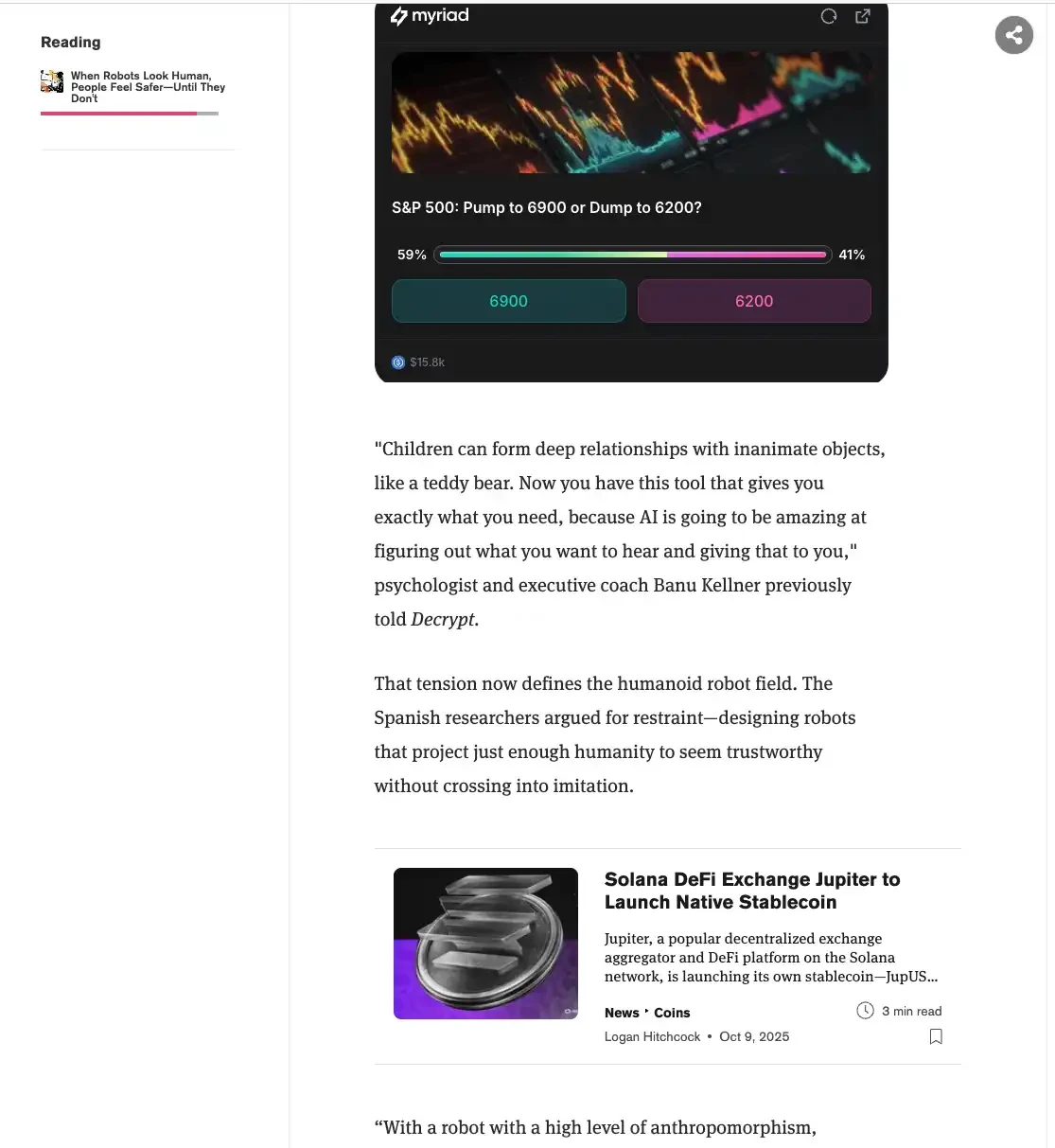
Experienced traders also create low-friction markets to pump volume. Myriad allows users to create custom markets. Some veteran traders act as "landlords," setting up small, short-term, low-contention markets and using Points as initial liquidity to create depth on both the buy and sell sides. For example, they might choose a simple, straightforward crypto or sports event (e.g., will PNKSTR break $400 million in market capitalization in October?).
Since these niche markets initially have limited participants, creators can use a small amount of points to create volume on both the buy and sell sides, creating an appearance of active trading and attracting other users. Of course, the platform also has mechanisms to detect and prevent purely self-trading attempts to manipulate the rankings, so operations must ensure a degree of genuine randomness, rather than simply robotic buying and selling. Overall, by leveraging the free creation and matching nature of the points market, players can dramatically increase the number of transactions in their accounts.
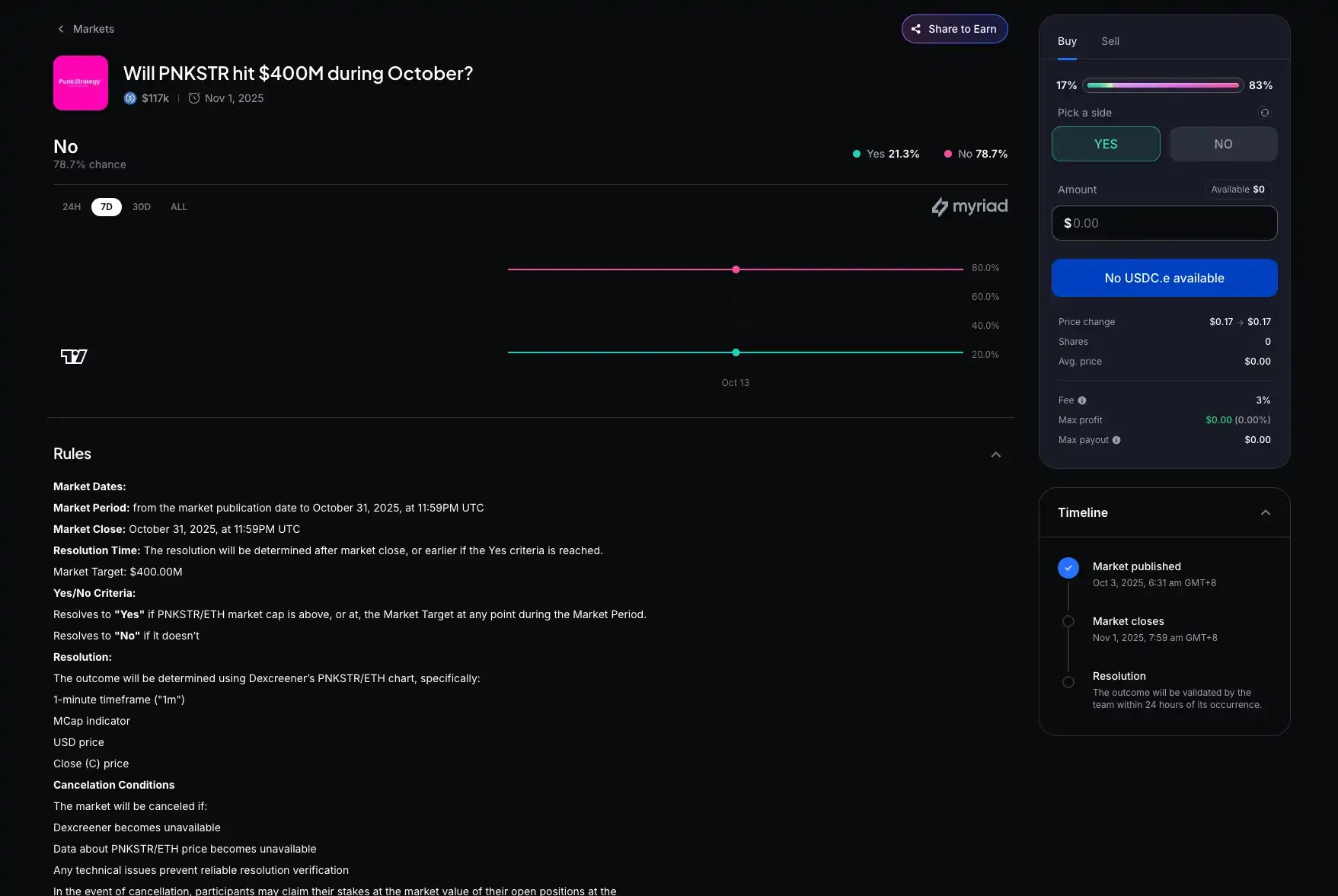
Because Myriad is still in its early stages of development, active users often receive unexpected rewards. For example, in an official ranking competition, the top 100 users received priority subscription to future $MYR tokens. For example, users who participated in community testing and submitted effective feedback were whitelisted for the first round of airdrops. Therefore, beyond simply increasing trading volume, actively engaging with the community and following the official Discord channel often yields additional hidden benefits.
In short, Myriad provides an innovative platform for users to practice and participate in prediction markets with a low barrier to entry. By leveraging the points system and media embedding, users can accumulate experience points in advance without taking any financial risk. Once the platform issues tokens or introduces more reward mechanisms in the future, these accumulated quantitative gains will have the potential to transform into qualitative changes.
Limitless
Limitless is an emerging prediction market platform deployed on the Base blockchain. Since its launch in 2024, it has experienced rapid user growth, with cumulative trading volume exceeding $400 million and over 37,000 active users. Its product design draws inspiration from the order book model of centralized exchanges, supporting the splitting and merging of yes/no positions to improve capital utilization, and allowing users to trade event markets consisting of multiple options.
Limitless has announced the upcoming issuance of its platform token, $LMTS. Despite previous accusations of "washing" trading volume, its experienced investors have fueled market enthusiasm, leading to a 200-fold oversubscription of its presale on Kaito during the National Day holiday. The points program, which served as the basis for airdrops in Season 1, has concluded, and the program has entered Season 2 (starting September 22, 2025, and running until January 26, 2026). During this period, users can still earn points through trading, providing liquidity, and inviting new users.

There are two strict requirements for participating in the Limitless points program. First, the account's cumulative trading volume must reach $200 to be eligible for inclusion in the points rankings. Second, the platform places great emphasis on trading quality, stating that it will filter out purely random order-washing behavior. Only transactions that actively participate in the real market and provide "meaningful" liquidity will receive higher scores.
In other words, if you simply repeatedly trade small, insignificant orders, you may earn minimal points, or even no points at all. Conversely, diligently participating in popular markets and increasing order book depth by placing orders will receive higher points. Furthermore, proactively providing liquidity is also a key way to earn stable points. At the end of each season, the platform categorizes users into Silver, Gold, Platinum, and Diamond tiers based on their points, with each tier receiving bonus points (the highest Diamond tier receives an additional 20% points).
Since it's difficult to quickly accumulate significant points through simple small trades, players who engage in volume manipulation often first consider hedging to lock in large trades. This is done by using large and small accounts to gamble against each other in a market where the outcome is almost certain.
For example, let's say an event is about to expire and the outcome is highly uncertain. The Yes contract price has reached $0.998, while the No contract price is only $0.002. At this point, you could use Account A to buy 1,000 No contracts at $0.002 (costing approximately $2), while using Account B to buy 1,000 Yes contracts at $0.998 (costing approximately $998). These two opposing trades essentially represent a self-trading of 1,000 contracts across two accounts, generating a combined trading volume of approximately $2,000. However, regardless of the final outcome, the gain in one account almost offsets the loss in the other: If the result is Yes, Account B receives $1,000, and Account A's No position is wiped out, forcing both accounts to recover a combined loss of approximately $1,000, essentially recovering their principal. If the result is a No, Account A recovers $1,000, while Account B loses $998, essentially breaking even.
The core of this is to use large and small numbers to bet on the side with a winning rate of about 99% and the side with a winning rate of 1% respectively in a market close to settlement (about the last minute) when the outcome is almost determined, and use almost inevitable events to hedge and complete large-scale transaction volume.
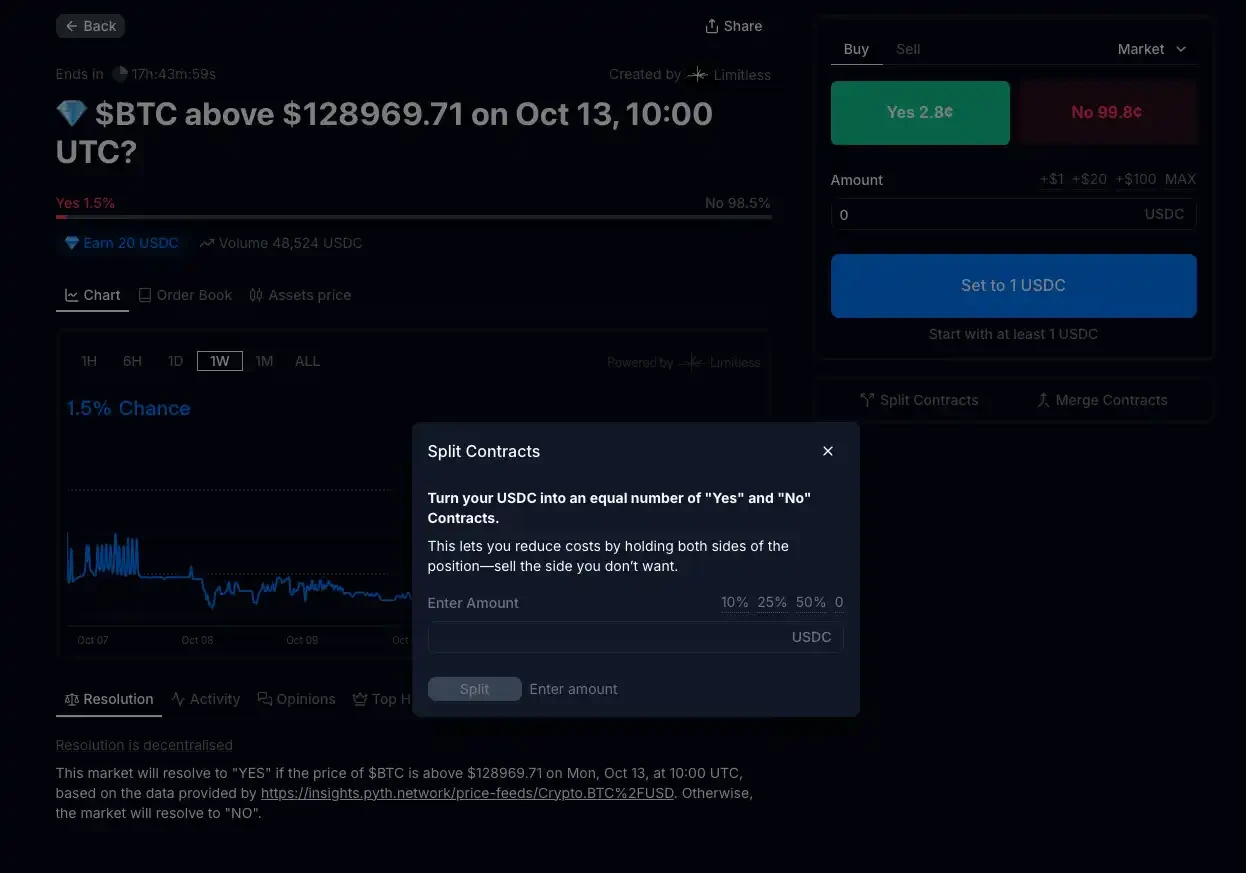
Another strategy is to cast a wide net and place orders to earn market maker points. Limitless also considers placing orders in the order book as providing liquidity when calculating user contributions, without requiring actual execution. Players can exploit this by placing large orders at extreme price points to exploit market depth. For example, placing 1,000 sell orders at 99.9% of the price (equivalent to being willing to sell Yes or buy No at $0.999). Because the price is close to 100%, the actual margin used for this order is less than $1. In other words, with only $1 in capital, you have provided 1,000 shares of market depth. Once the system detects your order during point calculation, points will be awarded accordingly. You can place similar orders at multiple prices simultaneously, earning high points at a very low cost.
Of course, these orders are unlikely to actually be executed (unless in extreme market conditions), so there's little risk of loss. However, it's important to be mindful of the platform's monitoring mechanisms. Overly deliberate and mechanical large orders can draw attention. It's best to place them in a dispersed manner across active markets to create a more natural appearance of liquidity provision.
While Limitless encourages wash trading, considerations for trading quality mean users should carefully consider their strategy when engaging in wash trading to avoid low points and ratings. Hedging solely in unpopular markets is likely to be considered invalid trades. Wash trading can be performed in popular markets, and hedging operations should be conducted in markets with real trading volume to avoid being conspicuous.
On the other hand, some regular trading should be done appropriately to establish a realistic profit or loss record. Some community users have shared that they combine pumping with real betting. After completing the required trading volume, they use a small portion of their funds to bet on one or two events they are confident will generate profit. This helps offset the fees paid during the pumping process and also helps create a more natural profit and loss curve for the account. Accounts that combine high volumes of trading with a good win rate are likely to be favored by the official in the future.
At present, Limitless has clearly stated that it will distribute $LMTS tokens through airdrops at the end of this season. The second season will last until the end of January next year. At the same time, as a member of the Base ecosystem, Limitless benefits from the "killing two birds with one stone" created by Base's already certified possible airdrops. In addition, with the support of top institutions such as Coinbase Ventures, its long-term development prospects are generally optimistic.
- 核心观点:预测市场赛道获巨额融资,空投策略受关注。
- 关键要素:
- Polymarket推流动性奖励和持仓收息机制。
- Kalshi交易量激增,占60%市场份额。
- Limitless公布代币计划,积分活动进行中。
- 市场影响:推动预测市场活跃度和用户参与。
- 时效性标注:短期影响



